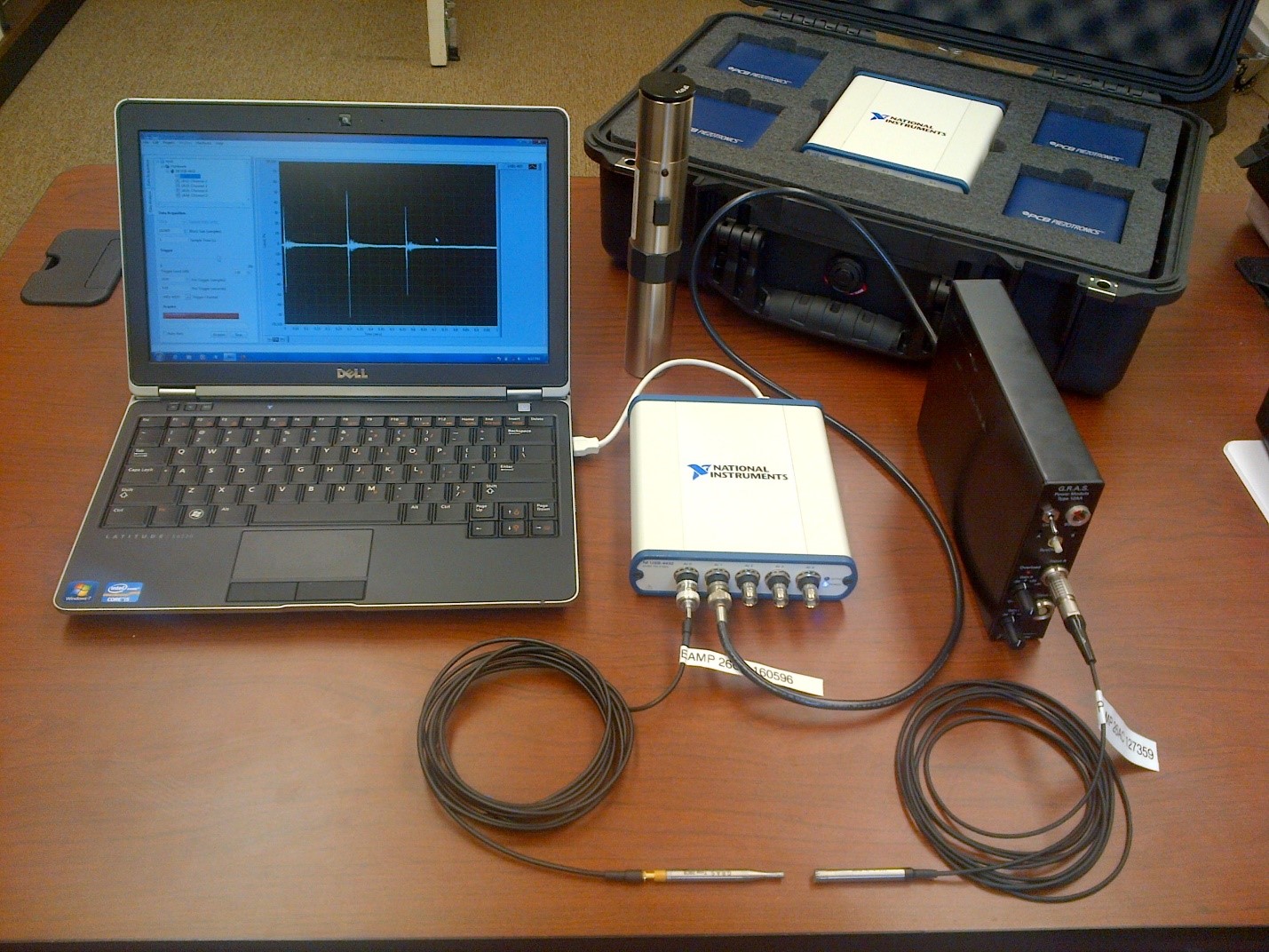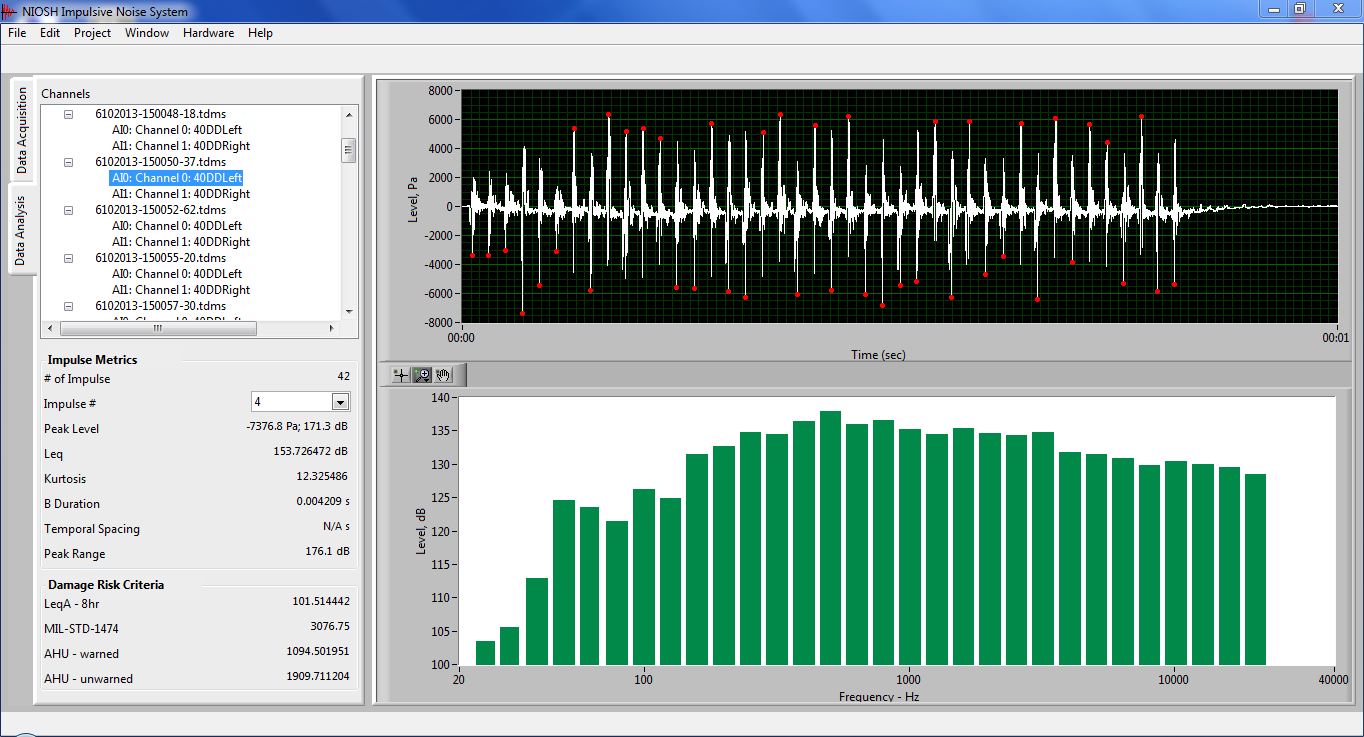How Can we Measure Impulse Noise Properly?
Posted on byImpulsive noise is typically generated by the rapid release of compressed gases (impulse) or the collision of solid objects (impact) and is defined as the instantaneous change in sound pressure over a short period of time. Considerable research has shown that impulsive noise is more likely to cause noise-induced hearing loss (NIHL) than continuous noise of equal energy. Exposure to high-intensity impulses can cause acoustic trauma and instant mechanical damage to the inner ear. Exposure to impulsive noise is common among law enforcement and military personnel (e.g. firearms) and in construction (e.g. nail guns), manufacturing (e.g. forging, stamping), and mining sectors (e.g. roof bolting).
At NIOSH, we often get questions about impulsive noise and the proper techniques for measuring high-level impulses. This blog is the first of a series that we intend to publish on impulse noise measurement, risk characterization, and the best way to protect workers against such exposures. This blog gives background information about impulse noise measurement and guidance based on NIOSH studies and current best practices.
Impulse sound levels, especially those generated by firearms or fireworks, can reach peaks of 170-180 dB Sound Pressure Level (SPL) or higher. Many sound measurement instruments are not capable of accurately capturing such intense sound levels. Type 2 noise dosimeters and sound level meters tend to max out around 140-146 dB SPL. These limitations are highlighted in the article Limitations of Using Dosimeters in Impulse Noise Environments [Kardous and Willson 2004]. Below is an image from that publication using a noise dosimeter taken at a firing range; the green line shows the clipping of peak sound pressure levels above 146 dB SPL. If the peak levels are clipped, then the entire measurement – and metrics such as TWA and Dose – are likely to be compromised.

Some manufacturers offer high-end, Type 1, sound level meters equipped with ¼-inch microphones that can measure impulses up to 160+ dB SPL. But even if a peak sound pressure level can be accurately captured (without clipping), peak level is not even the main metric used to characterize hearing risk from impulsive noise!
Researchers have identified several other metrics that are more closely associated with characterizing the risk of exposure to impulsive noise and have been cited as important factors in determining risk from exposure to impulsive noise [CHABA 1992], they include:
- Total energy in an impulsive waveform
- Initial duration of an impulse, often referred to as A-duration
- The reverberation following the initial impulse such as B, C or D-durations
- The relative high or low-frequency content in an impulse
- The number and temporal spacing of impulses in an entire exposure
- The kurtosis of an impulsive event (a statistical metric that is sensitive to the peak and temporal characteristics of a noise)
Another approach that was recently adopted by the U.S. Department of Defense is the Auditory Hazard Assessment Algorithm for Humans (AHAAH), an electro-acoustic model of the ear that assigns “Auditory Hazard Units” to an impulsive exposure [DOD 2015]. One of the main things we can say at this point is that methods for estimating damage risk criteria from exposure to impulsive noise is an active area for ongoing research.
NIOSH has been investigating the effects of impulsive noise for quite some time now. In 2003, we convened a Best Practices workshop on impulsive noise and published the findings from the various working groups in the Noise Control Engineering Journal under the title NIOSH/NHCA Best-Practices Workshops on Impulse Noise [Kardous et al., 2005].
To address the need for making accurate worksite impulsive noise measurements, NIOSH engineers developed and patented a portable, self-contained impulse noise measurement system . The laptop/tablet based system can be acquired commercially as a self-contained kit in a single case (shown below).

The system can measure impulses up to 186 dB SPL (192 dB SPL using very low sensitivity polarized microphones) in real time; it can be manually or automatically triggered and supports up to 5 acquisition channels with a sampling rate of 102 kHz (a chassis-based system can support up to 16 channels with a sampling rate of 204.8 kHz per channel). The system has the capability to store waveforms and provide immediate analysis and calculations of relevant impulse noise metrics (peak level, B duration, frequency spectrum as FFT and octave band, temporal spacing, number of impulses, kurtosis, and Leq). The system also calculates several damage-risk criteria currently in use: LeqA8hr, MIL-STD-1474D/E, and AHAAH (as shown in Figure 3). A detailed description of the system, its setup and operation, as well as its intended uses are described in the report Development and Validation Testing of an Impulse Noise Meter.


The system has been deployed by NIOSH researchers on several recent surveys and health hazard evaluations to measure law enforcement and military personnel exposures to impulse noise from firearms: Development and Validation Testing of an Impulse Noise Meter and Measurement of Exposure to Impulsive Noise at Indoor and Outdoor Firing Ranges during Tactical Training Exercises Figures 4 and 5 show photographs from those surveys to give the reader an idea about field implementation.

Such surveys and detailed noise impulse assessments are not possible by simply using a sound level meter and that is why a dedicated impulse noise measurement system is needed. Knowing the characteristics of the impulse waveform is critical to understanding the risk of any high-level impulse noise exposure. Using the NIOSH impulse noise system allows our researchers to capture impulses and calculate risk metrics, in real-time, and provide appropriate recommendations to reduce the risk of hearing loss. As data acquisition, digital signal processing, and storage capabilities continue to improve, it is crucial for sound measurement instruments targeted at measuring impulsive noise to:
- be redesigned to capture high-level impulses,
- have the capability to store the entire impulse waveform or impulsive event, and
- incorporate appropriate impulse-specific metrics into their capabilities.
We are currently wrapping up a study to develop new guidelines for exposure to impulsive noise, which will be used to update our occupational noise exposure criteria document. NIOSH hearing loss prevention researchers have also conducted studies on the performance of hearing protection devices in impulse noise environments; a follow-up blog on that subject will be published soon. For more information about impulsive noise research and hearing loss prevention in general, check out our topic page and follow us on Twitter at @NIOSHNoise.
CAPT Chucri (Chuck) A. Kardous, MSEE, PE, is a senior research engineer in the NIOSH Division of Applied Research and Technology.
CAPT William J. Murphy, PhD, is a senior research physicist in the NIOSH Division of Applied Research and Technology.
References:
CHABA [1992]. Hazardous exposure to impulse noise. Washington, DC: National Research Council, Committee on Hearing, Bioacoustics, and Biomechanics. http://www.dtic.mil/docs/citations/ADA382167
Kardous CA, Willson RD [2004] Limitations of using dosimeters in impulse noise environments. J Occup Environ Hygiene 1(7):456-462. DOI: 10.1080/15459620490465839
Kardous CA, Franks JR, Davis RR [2005]. NIOSH/NHCA best-practices workshops on impulsive noise. Noise Contr Eng J 53(2):53-60. DOI: 10.3397/1.2839245
U.S. DOD [2015]. MIL-STD-1474E. Design Criteria Standard, Noise Limits. U.S. Department of Defense, Washington, D.C. https://www.arl.army.mil/www/pages/343/MIL-STD-1474E-Final-15Apr2015.pdf
Posted on by

